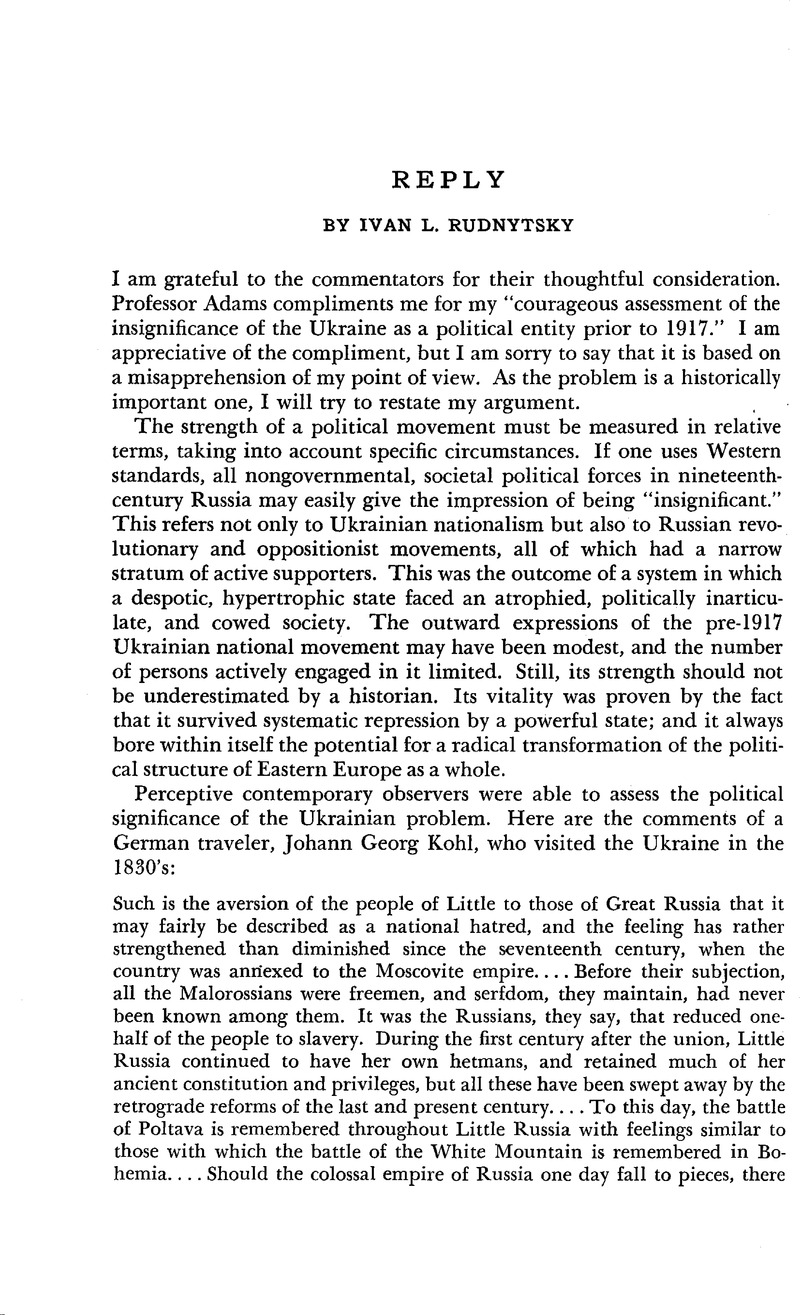No CrossRef data available.
Article contents
Abstract

- Type
- Discussion
- Information
- Copyright
- Copyright © Association for Slavic, East European, and Eurasian Studies. 1963
References
1 Kohl, J. G., Russia: St. Petersburg, Moscow, Kharkoff, Riga, Odessa, the German Provinces of the Baltic, the Steppes, the Crimea, and the Interior of the Empire (London, 1844), p. 527–29.Google Scholar
2 The report of Eduard Sedlaczek, drawn from the archives of the Ministry of Foreign Affairs in Vienna, has been published by Dmytro Doroshenko. See , ![]() (Warsaw, 1938), pp. 59-70. The passages quoted are on pp. 63-65.
(Warsaw, 1938), pp. 59-70. The passages quoted are on pp. 63-65.
3
![]() (Kiev, 1912).
(Kiev, 1912).
4 A test of strength of the Ukrainian movement was the election to the Russian Constituent Assembly in the late fall of 1917. “The five million votes obtained in the clear by the various Ukrainian lists constitute an impressive showing from any point of view, and must be augmented by at least another half million votes as the Ukrainian share of the joint lists agreed upon with other parties…. In the face of such a clear-cut demonstration of strength, it is simply not possible to contend that the Ukrainian movement was a weak and artificial thing, concocted by a group of hyper-nationalistic intellectuals.” Radkey, Oliver Henry, The Election to the Russian Constituent Assembly of 1917 (Cambridge, Mass.: Harvard University Press, 1950), pp. 18 and 30Google Scholar. The validity of this test has been explicitly recognized by Lenin himself. Rosa Luxemburg, like Professor Adams, believed that the Central Rada was without a mass basis, and she criticized Lenin for the “coddling“ of Ukrainian nationalism. In justifying his policy Lenin referred to the results of the election to the Constituent Assembly as a proof that the Ukrainian movement was a force to be reckoned with. It is to be noted that in the eight provinces of the Ukraine the Bolsheviks obtained only 10 per cent of votes. Cf. Jurij, Borys, The Russian Communist Party and the Sovietimtion of Ukraine (Stockholm, 1960), pp. 159–60 Google Scholar.
5 The background of the Skoropadsky coup has been recently studied by Oleh S. Fedyshyn from German archival sources. It appears that Skoropadsky was not hand-picked by the Germans. The right-wing conspiracy against the socialistic Rada government was formed by Skoropadsky on his own initiative. German military authorities arrived independently at a decision to get rid of the “uncooperative” Central Rada. The two parties reached an agreement only a few days before the coup of April 29, 1918. See Oleh S. Fedyshyn, “German Plans and Policies in the Ukraine, 1917-1918” (unpubl. doctoral dissertation, Columbia University, 1962).
6 W., Kutschabsky, Die Westukraine im Kampfe mit Polen und dem Bolschewismus in denjahren 1918-1923 (Berlin, 1934), p. 1 Google Scholar.
7
![]() (Moscow, 1960), 274
(Moscow, 1960), 274




